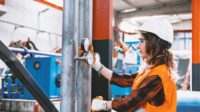Continuing with the theme of testing, adjusting, and balancing (TAB) from my recent columns, this month I would like to suggest that some projects should undertake TAB work first in an existing building renovation and/or addition. In fact, if existing HVAC systems are going to be reused in any way to serve the newly renovated/added spaces, the first round of TAB work should be performed during the design phase.
If the design team intends to reconfigure and/or reuse existing air or water systems, it is imperative for the effective and efficient completion of the project that the current performance capabilities of each of those systems be known and not assumed. Depending solely on equipment schedules from the original design drawings and/or installed equipment nameplate data is risky, especially when it takes such a small investment in a TAB contractor’s services to obtain current, reliable data.
In only one day on-site, a qualified TAB contractor can measure and document air and water system flows, pressure profiles, and electrical characteristics for multiple existing systems. From this data, the design engineers can use the laws of physics to confidently predict how the existing systems will perform when reconfigured and/or expanded to serve the new project spaces and/or equipment.
Predesign TAB attention will also uncover existing equipment deficiencies that need to be repaired, either before the project begins or as a part of the project, in order for the systems to perform as needed at the end. These can include broken damper linkages, seized-up control valves, failed check valves, closed smoke dampers, missing fan belts, out-of-calibration airflow measuring stations and/or flow meters, etc.
Discovering such deficiencies during post-construction balancing risks bringing the HVAC system’s progress to a screeching halt while the owner and contractors deliberate about who is responsible for fixing the deficiencies.
If a renovation project is to be undertaken in a fully or partially occupied building, TAB may be required throughout the project to ensure that proper ventilation, temperature control, and space pressure relationships are maintained for all occupants during construction. This is particularly true in phased projects where the construction zone moves through different areas of the building as the project progresses.
Each phase is a different combination of people in temporary swing spaces, recently completed spaces with new permanent occupants, and unoccupied areas under construction. The requirements of the existing and/or new HVAC systems change from phase to phase, but the importance of providing healthy and comfortable working conditions for all occupants does not. As such, the design engineers should provide unambiguous air and water flow requirements that need to be balanced and documented by the TAB contractor upon completion of each phase.
If the intent is to continue serving out-of-scope, occupied spaces throughout construction with an air-handling system that is being modified as part of the project, careful analysis and pre-construction duct pressure readings can help avoid the need to manually rebalance the existing occupied spaces every time there is a change to the central air-handling system and its distribution ductwork. The TAB contractor can measure and document pre-construction static pressures in all branch ductwork serving out-of-scope spaces. The objective during construction will be to maintain those static pressures during all occupied times. This can be done with daily or weekly manual pressure readings or through the addition of static pressure sensors for continuous trending via the building automation system.
A similar approach can be taken with hydronic systems, where the differential pressures across existing-to-remain sections of the piping system are maintained at pre-construction levels during construction.
As with so many elements of the commissioning process, a thoughtful approach to pre-design, pre-construction, and mid-construction TAB work can greatly enhance an HVAC system renovation’s success and timely completion. It takes most of the guesswork out of the design of existing systems’ modifications, keeps building occupants safe and comfortable during construction, and helps avoid unpleasant surprises during and at the end of the project.





